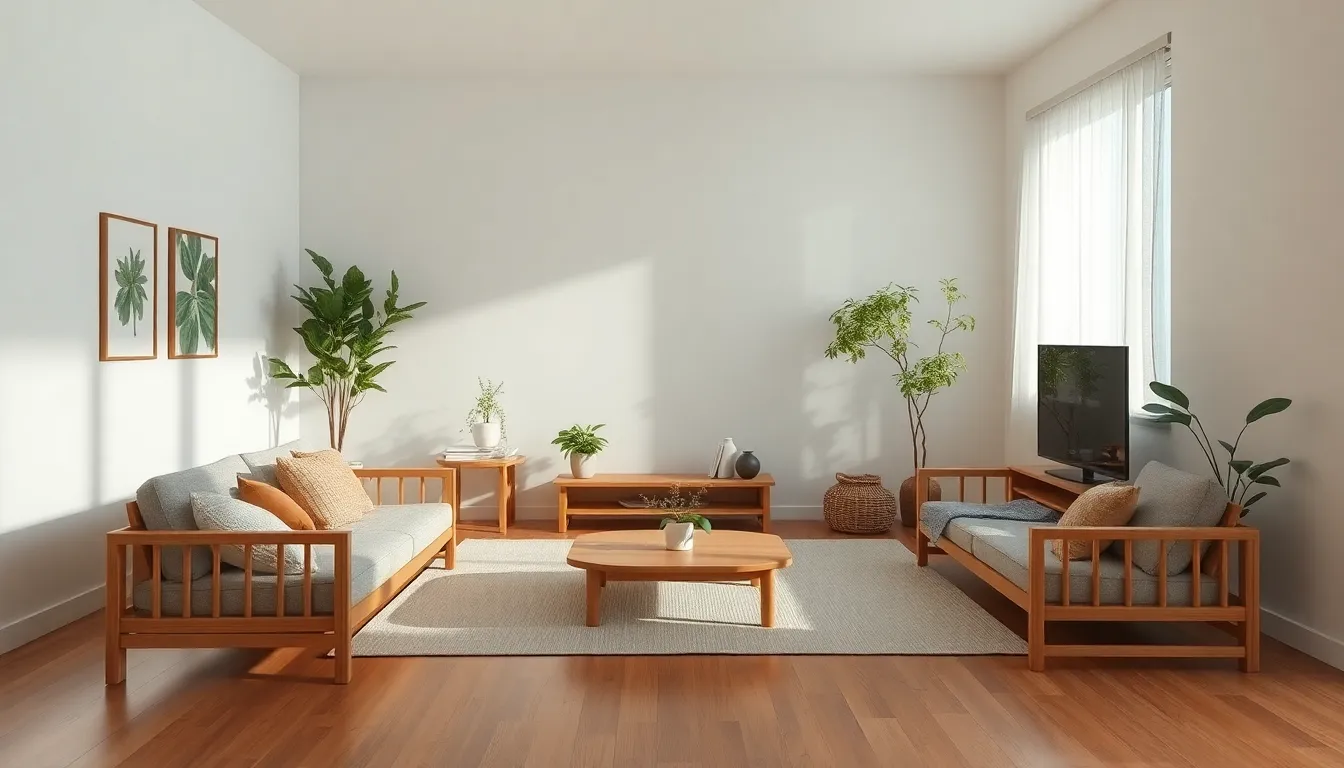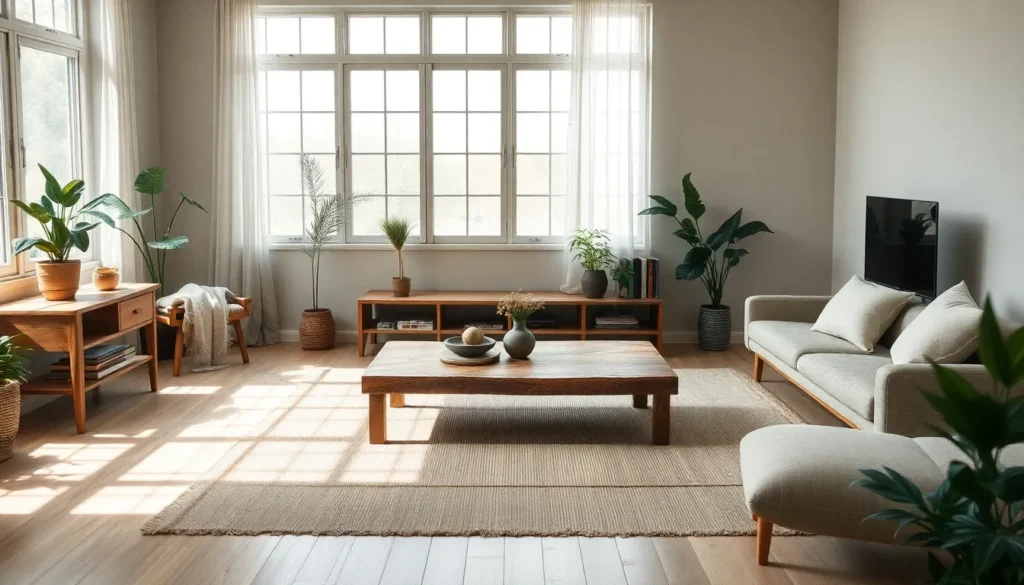Imagine stepping into a living room that feels like a serene retreat from the chaos of everyday life. The Japandi style—a harmonious blend of Japanese minimalism and Scandinavian functionality—offers just that. It’s all about creating a space that’s not only stylish but also uncluttered and inviting. Who wouldn’t want to kick back in a room that feels like a zen garden meets a cozy cabin?
Table of Contents
ToggleUnderstanding Minimalist Lifestyle
Minimalist lifestyle focuses on simplicity and intentionality in one’s living space. This approach emphasizes the removal of excess to create a calm, organized environment.
Key Principles of Minimalism
Clarity thrives in a minimalist setting. Space design prioritizes functionality, selecting furniture that serves a purpose while contributing to overall aesthetics. Natural light plays a crucial role, enhancing openness and inviting a sense of peace. Selection of color palettes embraces neutrals and earthy tones, establishing a soothing atmosphere. Quality over quantity resonates deeply, favoring handcrafted items over mass-produced alternatives.
Benefits of Minimalist Living
Mental clarity improves in a minimalist environment. Fewer distractions lead to enhanced focus and productivity. Financial benefits emerge as decluttering reduces unnecessary purchases, promoting mindful spending. Time management receives an upgrade, streamlining daily routines with fewer possessions to organize. Emotional wellbeing rises as individuals experience less stress from clutter, fostering a serene atmosphere for relaxation.
Exploring Japandi Design

Japandi design merges the simplicity of Japanese aesthetics with the functionality of Scandinavian style. This combination results in a living space that promotes tranquility and comfort.
Characteristics of Japandi Style
Japandi style emphasizes minimalism. Clean lines dominate the furniture, creating an open and spacious feel. Natural materials, such as wood and bamboo, enhance warmth while promoting sustainability. Neutral and muted color palettes, including whites, grays, and earthy tones, encourage a calming atmosphere. Thoughtful decor pieces reflect craftsmanship and intention. Each element serves a purpose, minimizing clutter and distraction.
Combining Japanese and Scandinavian Elements
Japanese elements are known for their simplicity and natural beauty. Scandinavian design enhances this with a focus on functionality and comfort. Low-profile furniture exemplifies versatility and practicality, catering to both aesthetics and usability. Indoor plants introduce a touch of nature, connecting the outdoors with the interior. Textiles, such as warm wool and soft linens, add texture and coziness, fostering an inviting environment. Together, these influences create a cohesive and serene living space.
Creating a Minimalist Lifestyle Japandi Living Room
Creating a minimalist Japandi living room involves careful consideration of colors, materials, and furniture. This design aims to establish a tranquil atmosphere by merging styles.
Color Palette and Material Choices
A neutral color palette is crucial in Japandi design. Soft beiges, muted grays, and warm whites provide a calming backdrop. Natural materials enhance this effect, with wood and bamboo adding warmth and sustainability. Selecting textiles in organic fabrics further complements the serene aesthetic. Natural light also plays a significant role; it helps maintain an open and airy feel, enhancing the overall ambience.
Furniture Selection for a Japandi Living Room
Furniture choices reflect both functionality and simplicity. Low-profile pieces, such as sleek sofas and low coffee tables, create a sense of space. Bamboo and solid wood are favored due to their durability and connection to nature. Intentionality in selecting decor ensures each item contributes to the serene environment. The use of multipurpose furniture allows for efficient space utilization, minimizing clutter while maximizing comfort. Plants serve as natural decor, adding life while reinforcing the connection to the outdoors.
Decor Ideas for a Japandi Living Room
Japandi living rooms emphasize simplicity with a blend of natural and functional elements. To enhance this aesthetic, decor choices focus on creating a harmonious environment.
Incorporating Natural Elements
Plants serve as essential decor, introducing a touch of nature indoors. Selecting low-maintenance varieties, such as snake plants or bonsai trees, fits well with minimal upkeep. Wood accents add warmth and texture, so consider a coffee table made from reclaimed wood. Bamboo details in accessories foster a sustainable and organic feel. Rock or pebble arrangements bring an earthy quality that complements the overall relaxation theme. Natural fibers, such as linen or cotton, used in textiles enrich the ambiance, promoting a serene environment.
Tips for Minimalistic Decor
Streamlined furniture remains a top priority in Japandi design. Choose low-profile pieces that emphasize clean lines and simplicity. Opt for multifunctional furniture to maximize utility without cluttering space. Neutral color palettes create a cohesive backdrop, so incorporate soft tones that are easy on the eyes. Prioritizing quality over quantity fosters intentional choices, leading to fewer but meaningful decor items. Use decorative storage solutions cleverly to hide away items, maintaining an uncluttered look. Light, airy curtains allow natural light to flow, which is critical in enhancing the overall bright atmosphere.
Embracing a Japandi living room fosters a unique blend of tranquility and functionality. This style not only enhances the aesthetic appeal but also promotes a peaceful atmosphere that encourages mindfulness. By prioritizing natural materials and a neutral color palette, individuals can create a serene retreat within their homes.
Incorporating thoughtful decor and low-profile furniture further enhances the minimalist approach, allowing for a clutter-free environment that supports emotional wellbeing. As one adopts the principles of Japandi design, they’ll likely experience increased clarity and comfort in their everyday life. Ultimately, a Japandi living room isn’t just a design choice; it’s a lifestyle commitment to simplicity and intentionality.

